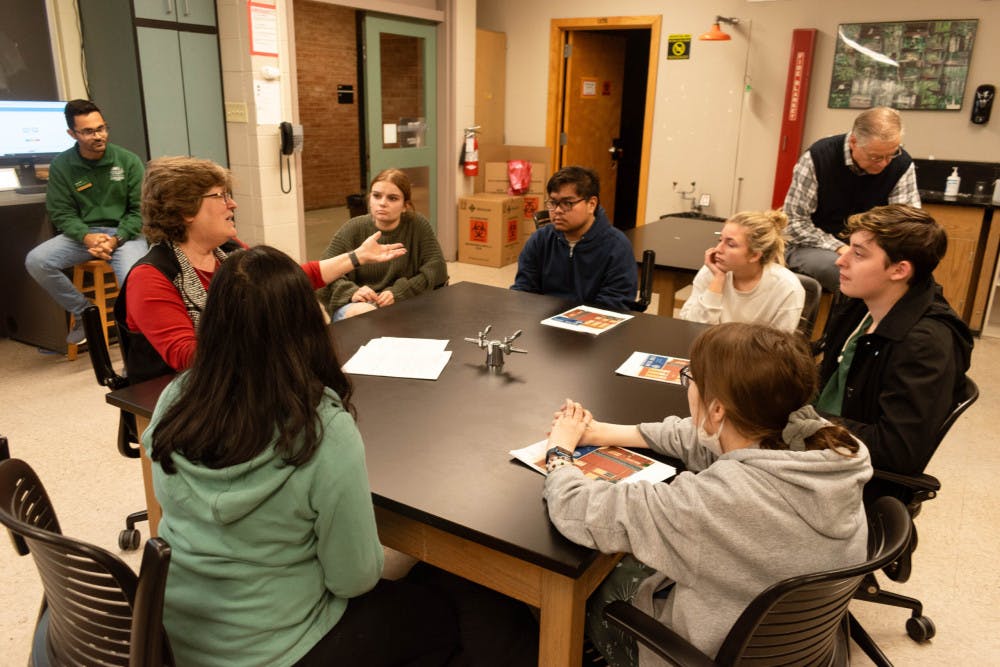RISE Tour | Photo by Emily Mancuso | The Wright State Guardian
Students of all majors gathered in Fawcett Hall on Dec. 1 to take part in the final RISE tour of the semester, studying blood spatter, fingerprinting, deviant behavior and more in the forensics-themed exploratory event.
About the RISE tours
The RISE tours, which are intended for Honors student exploration but are open to all students, do not just focus on forensics. Previous topics include a nursing simulation, a microelectronics lab and a physiology tour. These tours, including forensics, were well-attended, numbering at least 15 attendees each time.
Dean Shu Schiller of the College of Graduate Programs and Honors Studies originally proposed the RISE tours, which are now mostly operated by the student advisory board for the college. Students propose ideas during meetings and organize the tours from connections with professors and instructors they already have a relationship with.
At the tours, attendees are informed about opportunities and fields of study at Wright State University that they may have not otherwise known about.
“[Honor students] might not be aware of or might have forgotten about doing a departmental honors thesis. This opens their eyes on what they could do as their projects because then they can get to see various different things, find out what they are interested in, maybe make connections with different professors or graduate students that are at different stations,” Rahul Shah, the treasurer of the student advisory board for the College of Graduate and Honor Studies, said.
Shah also hopes attendees learn more about the over 100 graduate programs WSU has to offer.
The forensics RISE tour was refined based on student feedback from previous tours, such as having a timer for switching stations and extending the length of the tours from an hour to an hour and a half.
The forensics tour
The tour began at 3 p.m. in Fawcett Hall, a hotspot for forensic studies with its ample lab equipment. The cohort of instructors was highly decorated.
Dr. Dan Krane spoke first and talked about his professional career at Wright State. Dr. Krane worked on well-known cases, such as Casey Anthony and the Unabomber, with DNA testing and is now the CEO of Forensic Bioinformatics.
“I think [DNA evidence is] now more reliable and more robust than it was 30 years ago, and that it wouldn’t have been if we hadn't had a small number of people who were really holding proponents of DNA evidence at the onset and continue to hold proponents of DNA evidence to high standards today,” Krane said.
Krane helped make some of the stations a reality. There were five stations: social disorganization theory and crime statistics, forensic DNA profiling, forensic odontology, blood spatter analysis and fingerprinting. Each group of three to six students spent approximately 15 minutes at each station run by either a professor, faculty member or student.
Dr. Tracey Steele is an associate professor of Sociology specializing in gender, sexuality and criminology. Dr. Steele hosted the social disorganization theory and crime statistics station. Students discussed surprising crime statistics and analyzed images for deterrent infrastructure against crime.
“The relationship, for example, between age and crime, it's actually an inverse relationship, and if we walked everybody up from about the age of 70 to the age of 25 to an island somewhere, crime would almost be eradicated [on the island],” Steele said.
Environmental Sciences Ph.D. student Robin Richardson-Coy hosted the forensic DNA profiling station. Students mathematically calculated the likelihood of a DNA match by comparing two DNA profiles.
Kayci Johnson, a Biological Sciences masters student, led the forensic odontology station. Students bit into an emptied candy wax container to analyze their bite marks and learned more from Johnson about the field of forensic odontology.
Robert Hunkeler is an adjunct faculty for Sociology and Anthropology and works with the Montgomery County coroner. Hunkeler manned the blood spatter analysis and fingerprinting stations. Students saw how blood reacts to different surfaces, how to determine whether a substance is blood and how to properly lift and fingerprint.
The tour ended at 4:30 p.m. with a follow-up survey available to further improve the RISE tours.
Dr. Karen Lahm was also instrumental in organizing the tour but could not attend.
Shah hopes to have RISE tours each month of the next semester. The student advisory board is currently considering an MBA-centered RISE tour. Honors and graduate students receive emails for RISE tour sign-ups.













